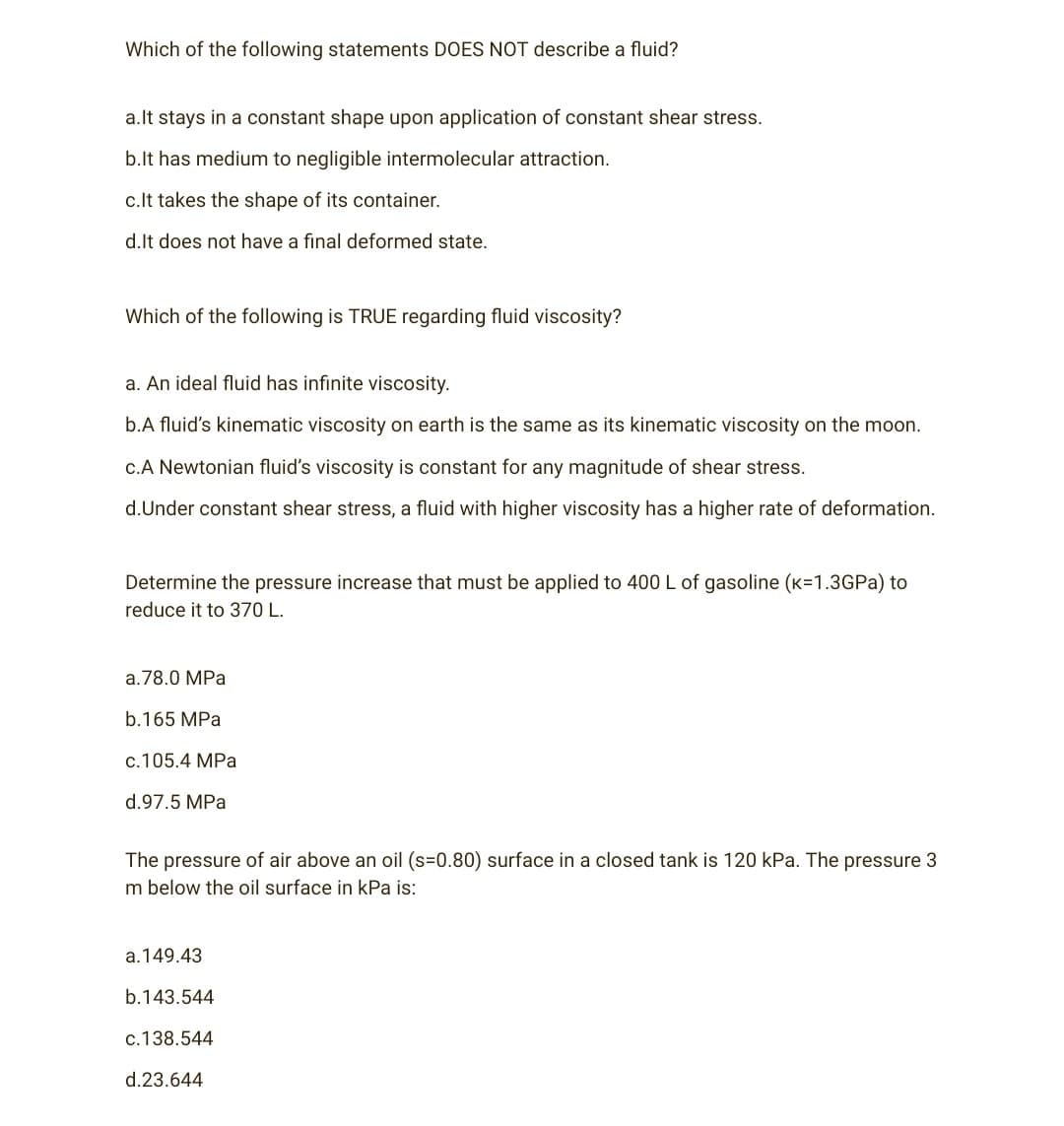Which of the following statements DOES NOT describe a fluid? a.lt stays in a constant shape upon application of constant shear stress. b.It has medium to negligible intermolecular attraction. c.It takes the shape of its container. d.It does not have a final deformed state. Which of the following is TRUE regarding fluid viscosity? a. An ideal fluid has infinite viscosity. b.A fluid's kinematic viscosity on earth is the same as its kinematic viscosity on the moon. c.A Newtonian fluid's viscosity is constant for any magnitude of shear stress. d. Under constant shear stress, a fluid with higher viscosity has a higher rate of deformation. Determine the pressure increase that must be applied to 400 L of gasoline (K=1.3GPa) to reduce it to 370 L. a.78.0 MPa b.165 MPa c.105.4 MPa d.97.5 MPa The pressure of air above an oil (s=0.80) surface in a closed tank is 120 kPa. The pressure 3 m below the oil surface in kPa is: a.149.43 b.143.544 c.138.544 d.23.644
Which of the following statements DOES NOT describe a fluid? a.lt stays in a constant shape upon application of constant shear stress. b.It has medium to negligible intermolecular attraction. c.It takes the shape of its container. d.It does not have a final deformed state. Which of the following is TRUE regarding fluid viscosity? a. An ideal fluid has infinite viscosity. b.A fluid's kinematic viscosity on earth is the same as its kinematic viscosity on the moon. c.A Newtonian fluid's viscosity is constant for any magnitude of shear stress. d. Under constant shear stress, a fluid with higher viscosity has a higher rate of deformation. Determine the pressure increase that must be applied to 400 L of gasoline (K=1.3GPa) to reduce it to 370 L. a.78.0 MPa b.165 MPa c.105.4 MPa d.97.5 MPa The pressure of air above an oil (s=0.80) surface in a closed tank is 120 kPa. The pressure 3 m below the oil surface in kPa is: a.149.43 b.143.544 c.138.544 d.23.644
Automotive Technology: A Systems Approach (MindTap Course List)
6th Edition
ISBN:9781133612315
Author:Jack Erjavec, Rob Thompson
Publisher:Jack Erjavec, Rob Thompson
Chapter3: Basic Theories And Math
Section: Chapter Questions
Problem 21RQ: While discussing friction in matter: Technician A says that friction creates heat. Technician B says...
Related questions
Question

Transcribed Image Text:Which of the following statements DOES NOT describe a fluid?
a.lt stays in a constant shape upon application of constant shear stress.
b.It has medium to negligible intermolecular attraction.
c.It takes the shape of its container.
d.It does not have a final deformed state.
Which of the following is TRUE regarding fluid viscosity?
a. An ideal fluid has infinite viscosity.
b.A fluid's kinematic viscosity on earth is the same as its kinematic viscosity on the moon.
c.A Newtonian fluid's viscosity is constant for any magnitude of shear stress.
d.Under constant shear stress, a fluid with higher viscosity has a higher rate of deformation.
Determine the pressure increase that must be applied to 400 L of gasoline (K=1.3GPa) to
reduce it to 370 L.
a.78.0 MPa
b.165 MPa
c.105.4 MPa
d.97.5 MPa
The pressure of air above an oil (s=0.80) surface in a closed tank is 120 kPa. The pressure 3
m below the oil surface in kPa is:
a.149.43
b.143.544
c.138.544
d.23.644
Expert Solution
This question has been solved!
Explore an expertly crafted, step-by-step solution for a thorough understanding of key concepts.
Step by step
Solved in 3 steps with 3 images

Knowledge Booster
Learn more about
Need a deep-dive on the concept behind this application? Look no further. Learn more about this topic, mechanical-engineering and related others by exploring similar questions and additional content below.Recommended textbooks for you

Automotive Technology: A Systems Approach (MindTa…
Mechanical Engineering
ISBN:
9781133612315
Author:
Jack Erjavec, Rob Thompson
Publisher:
Cengage Learning

Refrigeration and Air Conditioning Technology (Mi…
Mechanical Engineering
ISBN:
9781305578296
Author:
John Tomczyk, Eugene Silberstein, Bill Whitman, Bill Johnson
Publisher:
Cengage Learning

Automotive Technology: A Systems Approach (MindTa…
Mechanical Engineering
ISBN:
9781133612315
Author:
Jack Erjavec, Rob Thompson
Publisher:
Cengage Learning

Refrigeration and Air Conditioning Technology (Mi…
Mechanical Engineering
ISBN:
9781305578296
Author:
John Tomczyk, Eugene Silberstein, Bill Whitman, Bill Johnson
Publisher:
Cengage Learning